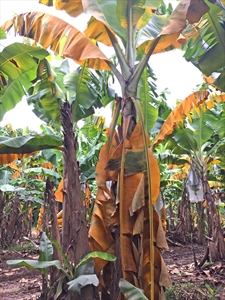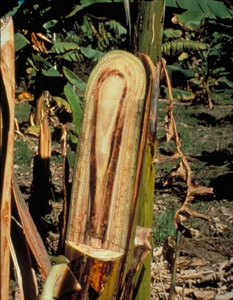Panama disease of banana, Fusarium wilt of banana.
Pacific Pests, Pathogens, Weeds & Pesticides - Online edition
Pacific Pests, Pathogens, Weeds & Pesticides
Banana Fusarium wilt (176)
Fusarium oxysporum f.sp. cubense
Fusarium wilt probably originated in Southeast Asia, but was first reported from Australia in 1876. Subsequently, it spread globally and is present in most parts of Asia, Africa and the Americas. It is now spreading in Pacific islands, and is present in Guam, Papua New Guinea and Tonga. This strain is Race 1. Importantly, it does not attack the Cavendish variety.
However, in recent years an aggressive Tropical race 4, or TR4 as it is called, has appeared which attacks the Cavendish variety, and this has caused great concern. The new strain was first detected in Asia in the 1990s, and until recently it was found only in Taiwan, Indonesia, Malaysia, the Philippines, China and northern Australia. Since 2010, outbreaks have been reported from Africa (Mozambique), the Middle East (Israel, Jordan, Lebanon, Oman), additional countries of Southeast and South Asia (India, Laos, Myanmar, Pakistan), and Australia (Queensland). In 2019, Fusarium TR4 was detected in Colombia, the first time it has been reported in South America. In 2021, it was reported from Peru.
Musa and Heliconia species.
There are four distinct races of this fungus, and one is divided into two strains. TR4 is the most serious as it affects a large number of varieties, including the popular Cavendish.
- Race 1 infects Gros Michel, and some plantains (e.g., Lady Finger cultivar in Australia (AAB group), but not Cavendish.
- Race 2 generally infects cooking bananas, e.g., Bluggoe and Blue Java.
- Race 3 infects only Heliconia species.
- Race 4 infects most varieties including Cavendish. There are two important strains:
o Subtropical Race 4 produces symptoms in Cavendish after a period of cold stress.
o Tropical Race 4 attacks Cavendish in tropical and sub-tropical conditions.
The fungus invades bananas through the fine (hair) roots, travelling through the roots and stem in the xylem or water-conducting tissues. Spores are produced, and these and the growth of the fungus block the flow of water and cause a wilt. Another type of spore, a 'chlamydospore', is produced in the soil; this is thick walled and allows the fungus to survive when there is no host to infect.
The first sign is a yellowing at the margins of older leaves, advancing towards the midrib (Photo 1). Leaves turn brown, dry, and eventually collapse. Disease symptoms move progressively from older to younger leaves until only a few of the youngest leaves remain green and erect, with the older ones forming a 'skirt' around the stem (Photo 2). Eventually, all the leaves collapse. On some varieties the stems split.
Internally, brown, red and yellow rings occur in the stem, at first at the centre and later, in cases of severe infection, spreading throughout the stem (Photo 3). Suckers may also show symptoms. Eventually, all parts above and below ground will die and rot.
Spread of Fusarium wilt over short distances is by root-to-root contact, in surface run-off water, in soil attached to vehicles, tools, footwear, animals, and in unsterilsed potting composts. Apparently, Fusarium wilt does not spread in soil by fungal growth. Over longer distances, spread occurs both within and between countries in infected planting material. However, the involvement of wind carrying spores or contaminated dust particles is still to be clarified.
Fusarium wilt can remain alive in soil for long periods, perhaps indefinitely, as resistant chlamydospores, in infested plant debris or in the roots of weeds that are hosts.
In the 1950s, Race 1 forced the banana export industry to change from Gros Michel to Cavendish when Fusarium wilt decimated production. Other races have appeared since then. It is estimated that 80% of global production is now under threat from TR4, which, if it spreads to Latin America, the Caribbean and West Africa, will have dire social and economic consequences. Not only will it devastate production, but also the livelihoods and food security of millions of smallholders who grow more than 85% of the crop. Additionally, there are potential environmental and biodiversity impacts as uncontaminated land would be cleared for cultivation, and difficult-to-grow varieties abandoned.
Look for leaves which turn yellow, beginning at the margins and, later, turn brown and dry out. Look for plants were leaves have collapsed and form a skirt around the stem. Look for dark brown to black discolouration of the water-conducting tissues when the stem is cut near ground level.
Management of Fusarium wilt is extremely difficult as the fungus remains alive in the soil for many years, and there are no fungicides or cultural controls that can be usefully applied against it. The only solutions are to: (i) keep it out in the first place; (ii) establish methods for early detection; (iii) observe strict hygiene measures; and (iv) use resistant varieties.
BIOSECURITY
The following advice applies to all strains of Fusarium wilt disease. However, such is the threat from TR4 that national and regional biosecurity authorities need to ensure that the fungus does not spread further in the world but, should a new introduction occur, have the necessary authority to apply quarantine regulations to limit its impact. Transfers of varieties between countries should follow the FAO/IBPGR Technical Guidelines for the Safe Movement of Germplasm. No. 15. Musa. 2nd Edition, (http://www.bioversityinternational.org/uploads/tx_news/Musa_spp.__2nd_edition__502.pdf).
A Panama disease tropical race 4 Grower Kit is avaialbe from the Queensland Governmenrt publications (https://www.publications.qld.gov.au/dataset/panama-disease-tropical-race-4-grower-kit).
BIOCONTROL
In the Davoa region of the Philippines, the fungus Trichoderma harzianum has been distributed to farmers.
CULTURAL CONTROL
Cultural control measures should be implemented to contain outbreaks once they have occurred.
Before planting:
- Never use suckers from mother plants which show symptoms, even though the suckers appear healthy. The suckers may have only just become infected, and the fungus is at a low level in the roots or stem.
- Use 'clean' planting material, preferably disease-certified plants growing in tissue culture. If these are not available, growers should be encouraged to take suckers only from areas that have not shown symptoms of the disease, if possible from their own farms which have been monitored for disease.
During growth:
- Avoid sharing farm machinery and equipment (e.g., shovels, knives and ladders) with other growers, and remove debris and soil from machinery (including vehicles), equipment, and footwear before entry to any farm, even farmers' own premises. Provide food and vehicle baths with disinfectants at strategic locations. Ensure that all members of the family (and other workers) know about the disease and the hygiene rules to keep it out of the farm and/or under control.
- If an infected plant is detected do the follow:
- Disturb the soil as little as possible. Dig out the plant with its root mass and suckers, and burn everything on the spot. Do not chop the plant into pieces. Use a herbicide (e.g., glyphosate) to hasten death of an infected plant. Then leave the plant to die in place.
- Consider removing a ring of plants surrounding the diseased one; this is done in case the disease has already spread to adjacent plants via root-to-root contact; never mind that they look healthy, they may develop the disease later.
- If possible, fence infected areas so that people do not spread the disease in soil on footwear, and use sodium hypochlorite (bleach) to clean the tools used to remove plants.
- As a future precaution, dig drains to divert surface run-off (and irrigation) water if it flows through the infested areas.
- Do not replant with the same or another Fusarium wilt susceptible variety where a diseased plant(s) has been removed, and monitor the remaining plants every 2 weeks.
- Once the disease is present, resistant cultivars, if available, and ways to suppress the fungus, for instance, soil amendments, are the next step, as well as the continuation of measures to prevent further spread within the plantation.
RESISTANT VARIETIES
The Cavendish variety is resistanct to Race 1. Tolerant and resistant varieties do exist to TR4:
i) Some FHIA (Honduran Agricultural Research Foundation) varieties (e.g., 01, 02, 18, and 25) have resistance to TR4.
ii) Work by the Taiwan Banana Research Institute has shown that the Giant Cavendish Tissue Cultured Variant 119 (GCTCV-119) has shown resistance. This variety was shared with the Philippines, where further selections were made in the infested fields of Davao, producing GCTCV-219. Check whether these are available locally.
CHEMICAL CONTROL
This is not a method that can be used against this soilborne disease.
AUTHOR Grahame Jackson
Information (and Photos 1&2) Diseases of fruit crops in Australia (2009). Editors, Tony Cooke, et al. CSIRO Publishing; and CABI (2020) Fusarium oxysporum f.sp. cubense (Panama disease of banana) and Fusarium oxysporum f.sp. cubense tropical race (TR4). Crop Protection Compendium. (https://www.cabi.org/cpc/datasheet/24621 and https://www.cabi.org/cpc/datasheet/59074053); and Panama disease tropical race 4 (TR4) (2021) Business Queensland. Queensland Government. (https://www.business.qld.gov.au/industries/farms-fishing-forestry/agriculture/crop-growing/priority-pest-disease/panama-disease); and from Dita M et al. (2018) Fusarium wilt of banana: current knowledge on epidemiology and research needs toward sustainable disease management. Frontiers in Plant Science. (https://doi.org/10.3389/fpls.2018.01468). Photo 3 Department of Agriculture and Fisheries, Queensland, Australia.
Produced with support from the Australian Centre for International Agricultural Research under project PC/2010/090: Strengthening integrated crop management research in the Pacific Islands in support of sustainable intensification of high-value crop production, implemented by the University of Queensland and the Secretariat of the Pacific Community.






